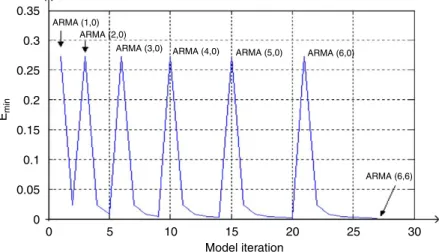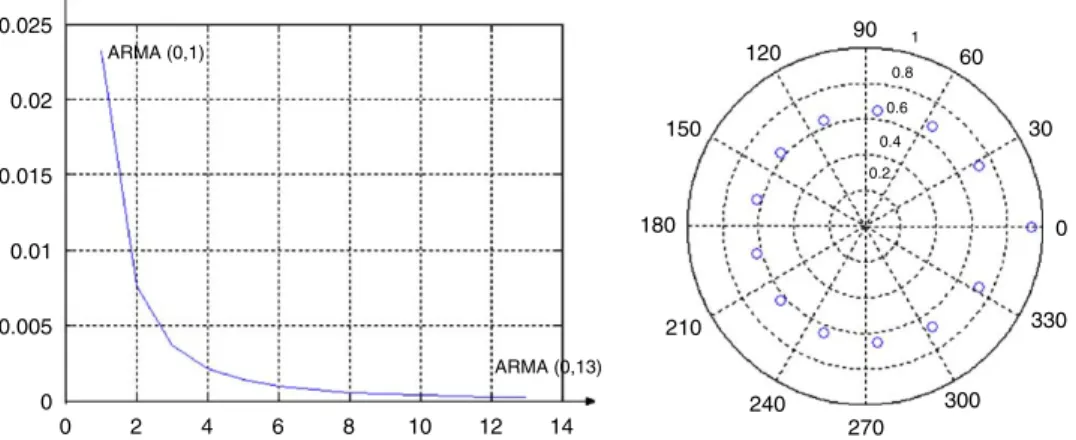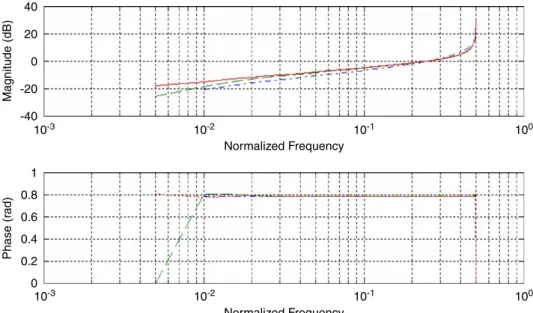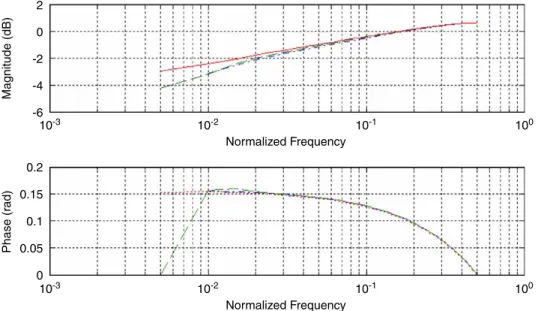Signal Processing 86 (2006) 2582–2591
A new least-squares approach to differintegration modeling
Manuel D. Ortigueira
a,b,, Anto´nio J. Serralheiro
b,caUNINOVA and DEE, Faculdade de Cieˆncias e Tecnologia da Universidade Nova de Lisboa, Campus da FCT da UNL, Quinta da Torre, 2829-516 Caparica, Portugal
bINESC ID, Rua Alves Redol, 9, 2o, 1000-029 Lisboa, Portugal cAcademia Militar and CINAMIL, Rua Gomes Freire, 1150-175 Lisboa, Portugal Received 20 May 2005; received in revised form 25 October 2005; accepted 14 December 2005
Available online 15 March 2006
Abstract
In this paper a new least-squares (LS) approach is used to model the discrete-time fractional differintegrator. This approach is based on a mismatch error between the required response and the one obtained by the difference equation defining the auto-regressive, moving-average (ARMA) model. In minimizing the error power we obtain a set of suitable normal equations that allow us to obtain the ARMA parameters. This new LS is then applied to the same examples as in [R.S. Barbosa, J.A. Tenreiro Machado, I.M. Ferreira, Least-squares design of digital fractional-order operators, FDA’2004 First IFAC Workshop on Fractional Differentiation and Its Applications, Bordeaux, France, July 19–21, 2004, P. Ostalczyk, Fundamental properties of the fractional-order discrete-time integrator, Signal Processing 83 (2003) 2367–2376] so performance comparisons can be drawn. Simulation results show that both magnitude frequency responses are essentially identical. Concerning the modeling stability, both algorithms present similar limitations, although for different ARMA model orders.
r2006 Elsevier B.V. All rights reserved.
Keywords: Discrete-time fractional differintegrator; Pseudo-fractional ARMA; Gru¨nwald–Letnikov derivative; Tustin bilinear transformation
1. Introduction
Fractional linear systems are described by frac-tional differential equations in the continuous-time case or ARMA models in the discrete-time case. The first case uses the definition of fractional derivative
[1]; the second uses the fractional differencing [2]. The long memory exhibited by these systems cannot be explained by the usual integer order pole/zero models. The basic building block of this kind of systems is the non-integer order derivative that has been approximated by fractional powers of the backward difference or the bilinear transformations (the former is exactly the building block of the fractional differencing). These approximations are IIR systems with non-rational transfer functions. However, these more correct models are difficult to implement and model in practice. For them, ARMA models are only approximations that we
www.elsevier.com/locate/sigpro
0165-1684/$ - see front matterr2006 Elsevier B.V. All rights reserved. doi:10.1016/j.sigpro.2006.02.013
Corresponding author. UNINOVA and DEE, Faculdade de Cieˆncias e Tecnologia da Universidade Nova de Lisboa, Campus da FCT da UNL, Quinta da Torre, 2829-516 Caparica, Portugal. Tel.: +351 21 2948520; fax: +351 21 2957786.
E-mail addresses:mdortigueira@uninova.pt, mdo@dee.fct.unl.pt (M.D. Ortigueira),
call pseudo-fractional ARMA models[3]. In the last few years, a lot of attempts to obtain such models have been done (see [4–9]). However, it remains to clarify two important questions: (a) how to perform such modeling and (b) how to choose the most suitable orders. In impulse response modeling the well-known Pade´ algorithm is frequently used[2]. In
[3], we presented a suitable recursive algorithm for this modeling. Here, we will propose a different algorithm based on a least-squares (LS) criterion different from [4]. This algorithm defines a mis-match error between the required response and the one obtained by the difference equation defining the ARMA model. In minimizing the error power we obtain suitable normal equations that allow us to obtain the ARMA parameters. The algorithm is described in Section 2 where we compare it with the algorithm described in [3] through some current modeling examples.
2. Least-squares ARMA approximation
2.1. The discrete-time fractional differintegrator
The differintegrator is a continuous-time linear system with transfer function given, in the causal case, by
FðsÞ ¼sa (1)
for ReðsÞ40[10]. To obtain discrete-time
differinte-grators, we replace the variablesin (1) by a suitable rational function of z1. The most commonly
used are:
(a) the backward difference, leading to a solution that is essentially the discretization of the Gru¨nwald–Letnikov derivative;
(b) the Tustin bilinear transformation.
Let the transfer function of these two fractional discrete-time systems be given, respectively, by
ðaÞHbdðzÞ ¼
1z1 T
a
; jzj41 (2)
and
ðbÞHbilðzÞ ¼
2
T
1z1
1þz1
a
; jzj41. (3)
Fractional differentiators and integrators are ob-tained, respectively, witha40 andao0.
The computation of the inverse Z-transform of (2) is simple using the binomial series expansion:
hbdðnÞ ¼
1
Ta
a
n
ð1Þnun¼
1
Ta
ðaÞ
n
n! un, (4)
whereun is the discrete-time Heaviside function and
ðaÞn ¼aðaþ1Þ. . .ðaþn1Þ is the Pochhammer symbol.
Considering (3), it can be seen that the correspond-ing impulse response is actually a convolution of two binomial sequences corresponding to the numerator and the denominator. It is not difficult to obtain
hbilðnÞ
2
T
a Xn
k¼0
ðaÞ
k
k!
ð1ÞnkðaÞ
nk
ðnkÞ! .
As
n!¼ ð1ÞkðnÞkðnkÞ! kpn (5) and
ðaÞn ¼ ð1Þkðanþ1ÞkðaÞnk (6) we obtain
hbilðnÞ
¼ 2
T
a
ð1ÞnðaÞ
n
n! Xn
k¼0
ðaÞ
kðnÞk
ðanþ1Þk ð1Þk
k!
¼ 2
T
a
ð1ÞnðaÞn
n! 2F1ða;n;anþ1;1Þ, ð7Þ
where 2F1(a,b;c,1) is the Gauss hypergeometric function that, for these arguments, does not have a closed form. (Prof. Volker Strehl, in a personal communication, stated that, almost surely,
2F1(a,n;an+1;1) satisfies a second order recursion formula.)
2.2. The algorithm
Both discrete-time representations are IIR sys-tems, but are not described by finite orders ARMA models. However, we intend to find approximations using finite orders ARMA models. There have been a lot of attempts to do it[4–6,8]. Here we propose a new LS identification algorithm different from that one proposed in[4].
will consider only these cases. The approximation we are looking for may be stated as
HðzÞ ¼ P1
m¼0fmzm
P1
n¼0gnzn
PM
m¼0bmzm
PN
n¼0anzn
. (8)
It is not difficult to see that we are dealing with an indeterminate problem, and we are going to propose an easy way to overcome it. Let (8) be written as
XN
n¼0 anzn
X1
m¼0
fmzmX
M
m¼0 bmzm
X1
n¼0
gnzn (9)
and make an inverse Z-transform to obtain
XN
n¼0
aifni
XM
i¼0
bigni; n2Zþ. (10)
This relation suggests us to define an error sequence by
en¼
XN
n¼0
aifni
XM
i¼0
bigni; n2Zþ. (11)
Let us assume that we haveLvalues of the impulse response we want to model. The error energy is given by
E¼X
L1
n¼0
e2n¼X
L1
n¼0
XN
n¼0
aifni
XM
i¼0 bigni
" #2
. (12)
Let a0¼1. We are now going to compute the
unknown parameters through the derivatives ofEin order to the ARMA parameters. This procedure is similar to that used in[11]. Therefore, we obtain the following sets of normal equations:
XL1
n¼0
XN
i¼0
aifnifnk
XM
i¼0
bignifnk
" #
¼0,
k¼1;2;. . .;N ð13Þ
and
XL1
n¼0
X
N
i¼0
aifnignkþ
XM
i¼0
bignignk
" #
¼0,
k¼0;1;2;. . .;M. ð14Þ
Introducing the covariance matrices:
Rffðk;iÞ ¼
X
L1
n¼0
fnifnk, (15)
Rgfðk;iÞ ¼
X
L1
n¼0
gnifnk, (16)
Rggðk;iÞ ¼
XL1
n¼0
gnignk (17)
we can rewrite (13) and (14) as
XN
i¼0
aiRffðk;iÞ
XM
i¼0
biRgfðk;iÞ ¼0; k¼1;2;. . .;N
(18)
and
XN
i¼0
aiRfgðk;iÞ
XM
i¼0
biRggðk;iÞ ¼0,
k¼0;1;2;. . .;N. ð19Þ If we know all the impulse response values or the theoretical expressions, we can compute the correla-tions
RffðkiÞ ¼
X1
n¼0
fnfnþik, (20)
RgfðkiÞ ¼
X1
n¼0
gnfnþik, (21)
RggðkiÞ ¼
X1
n¼0
gngnþik (22)
that allow us to rewrite (18) and (19) as
XN
i¼0
aiRffðkiÞ
XM
i¼0
biRgfðkiÞ ¼0,
k¼1;2;. . .;N ð23Þ
and
XN
i¼0
aiRfgðkiÞ
XM
i¼0
biRggðkiÞ ¼0,
k¼0;1;2;. . .;N. ð24Þ With this formulation all the involved matrices are Toeplitz matrices. However, we will maintain the notation introduced in (18) and (19). We can join all the matrices in only one. Introduce the matrices
U½ðNþ1Þ ðNþ1Þ;W½ðMþ1Þ ðNþ1Þ and H½ðMþ1Þ ðMþ1Þ that are easily identified and
aNb0b1b2. . .bMT: We join (18) and (19) into the
following system of equations:
U W
WT H
2 6 4 3 7 5 1 a1 .. . aN b0 .. . bM 2 6 6 6 6 6 6 6 6 6 6 6 6 6 4 3 7 7 7 7 7 7 7 7 7 7 7 7 7 5 ¼ Emin 0 : : : 0 2 6 6 6 6 6 6 6 6 6 6 6 6 6 4 3 7 7 7 7 7 7 7 7 7 7 7 7 7 5 . (25)
The solution is readily obtained by inverting the matrix. We only have to obtain the first column of the inverse and normalize the first coefficient. The normalizing constant is equal to Emin. The parti-tioned inverses formula can be used here [12]. To our needs it is enough to say that the first column of the following matrix is the solution (non-normal-ized) for our problem:
Emin 1 a1 .. . aN b0 .. . bM 2 6 6 6 6 6 6 6 6 6 6 6 6 6 4 3 7 7 7 7 7 7 7 7 7 7 7 7 7 5 ¼
ðUWH1WTÞ1
WH1WTðUWH1WTÞ1
2 6 4 3 7 5 1 0 : : : 0 2 6 6 6 6 6 6 6 6 6 6 6 6 6 4 3 7 7 7 7 7 7 7 7 7 7 7 7 7 5 (26)
provided that either ðUWH1WTÞ or H are
regular. If this is not the case, we can use
Emin 1 a1 .. . aN b0 .. . bM 2 6 6 6 6 6 6 6 6 6 6 6 6 6 6 6 6 4 3 7 7 7 7 7 7 7 7 7 7 7 7 7 7 7 7 5 ¼
ðU1þU1WðHWTU1WÞ1WTU1
ðHWTU1WÞ1WTU1
2 6 6 4 3 7 7 5 1 0 : : : 0 2 6 6 6 6 6 6 6 6 6 6 6 6 6 6 6 6 6 4 3 7 7 7 7 7 7 7 7 7 7 7 7 7 7 7 7 7 5 . ð27Þ
We remark here thata0¼1 and thus
XN
i¼1
aiRffðkiÞ
XM
i¼0
biRgfðkiÞ
" #
¼ RffðkÞ,
k¼1;2;. . .;N ð28Þ
and
XN
i¼1
aiRfgðkiÞ
XM
i¼0
biRggðkiÞ
" #
¼ RfgðkÞ,
k¼0;1;2;. . .;M. ð29Þ
This may be interesting because it allows a reduction in the dimensions of matrices U and W.
It is not difficult to obtain similar matrices to those in (25)–(27).
2.3. Applications
2.3.1. Difference
We are going to use the previous algorithm to compute the approximation to the differintegrator using the backward difference. Assume thata40. In
this case and referring to the notation used in the previous section, we have
fn¼ 1
Ta
ðaÞ
n
n! un (30)
and
gn ¼dn. (31)
Let the corresponding correlations be computed:
RffðnÞ ¼
1
T2a
X1
k¼0
a
k
!
ð1Þk a
kþn
!
ð1Þkþn
¼ 1
T2a
X1
k¼0
ðaÞk
k!
As
ðnþkÞ!¼ ðnþ1Þkn! (32)
and
ðaÞ
nþk¼ ðaÞnðaþnÞk, (33)
1
T2a
ðaÞ
n
n! X1
k¼0
ðaÞ
k
k!
ðaþnÞ
k
ðnþ1Þ! 1
T2a
ðaÞ
n
n! 2F1ða;aþn;nþ1;1Þ. ð34Þ
Using the Gauss formula
2F1ða;b;c;1Þ ¼
GðcÞGðcabÞ
GðcaÞGðcbÞ cab40 (35)
we obtain
RffðkÞ ¼
1
T2að1Þ
k Gð1þ2aÞ
Gðaþkþ1ÞGðakþ1Þ (36) meaning that theFmatrix is a symmetric Toeplitz matrix. Obviously
RgfðnÞ ¼
1
Ta
a
n
ð1Þnun. (37)
Then, C is a non-symmetric Toeplitz matrix. If ao0, it is enough to interchangefn withgn.
2.3.2. Bilinear
Assume again thata40. For thef
n sequence, we
use the above expression (30). Forgn we have
gn¼ a
n
un. (38)
The corresponding autocorrelation is
RggðkÞ ¼
Gð1þ2aÞ
Gðaþkþ1ÞGðakþ1Þ (39)
leading again to a symmetric Toeplitz matrix. The cross-correlation is given forn40 andao1
RfgðnÞ ¼
1
Ta
X1
k¼0
a
k
!
ð1Þk a
kþn
!
¼ 1
Ta
X1
k¼0
ðaÞk
k! ðaÞ
kþn
ðkþnÞ!
¼ 1
Ta
ðaÞ
n
n! X1
k¼0
ðaÞ
kðaþnÞk
ð1þnÞk
¼ 1
Ta
ðaÞ
n
n! 2F1ðaþn;a;nþ1;1Þ.
From Kummer’s formula[13]
2F1ða;b;abþ1;1Þ ¼
Gð1þabÞGð1þa=2Þ
Gð1þa=2bÞGðaþ1Þ,
bo1 and ab nonnegative integer
ð40Þ
we obtain
RfgðnÞ ¼
1
Ta
ðaÞ
n
n!
Gð1aþnÞGð1a=2þn=2Þ Gð1þa=2þn=2ÞGðaþnþ1Þ
¼ 1
Ta
ð1Þn GðaÞðaþnÞ
Gð1a=2þn=2Þ Gð1þa=2þn=2Þ.
ð41Þ
Ifno0
RfgðnÞ ¼ ð1ÞnRfgðnÞ (42)
leading to a non-symmetric Toeplitz matrix. In this case and if N¼M, we have
bi¼ ð1Þiai
suggesting the usage of an ARMA(N,N).
3. Comparisons
In this section we are going to use the above algorithm to compute approximations for the differintegrator. However, only the results for the differentiator (a40) are presented since, for
prac-tical purposes, the integrator does not constitute a different case study. This leads us to consider fractional orders a2 ½0:5;0:5. For comparisons, we will use the results presented in [3,4] whenever feasible.1
In order to get some insight into the order of the ARMA models, experiments with ARMA(n,m),n¼ 1;. . .;N and m¼0;. . .;n were performed. Figs. 1 and 2depict the behavior ofEmin, for the backwards difference and bilinear, respectively, as by Eq. (26) as a function of (n,m). It is interesting to note that in both cases, the local minima of Emin occur when
n¼m, that is, the number of poles equals the number of zeros. Also note that maxima correspond to AR(N) models.
Further simulations were carried out for both the backward differences and bilinear MA(M) models.
Fig. 3 (backward differences) and Fig. 4 (bilinear) depictEminas a function of model order (left graph) and the final zero map (right graph).
Based on the Emin behavior as a function of the order of the models, all the remaining experiments comprise only ARMA(N,N) models.
AsFigs. 5 and 6depict, there is no substantial or significant difference between the algorithm pro-posed in this work, LS, and that presented in[3].
In the LS case, higher ARMA orders can be thought but, for comparison purposes with the previous algorithm, we limited them to (9,9). In fact, using the LS approach, and for a¼0:5, we were able to estimate an ARMA(12,12), depicted in
Fig. 7. It should be pointed out that, for this same value ofa¼0:5, in[3]instability problems occurred forðN;NÞ49.
Changing the value ofa to 0.1 leads us toFig. 8 (backward differences) and Fig. 9(bilinear). These approximations are summarized inTable 1.
Values of jaj40:5 are not interesting to present
since they can be trivially reduced to a ‘‘new’’ fractional order a¼ ð1aÞ such that a 2 ½0;0:5 by including either an integrator or a differenciator that results in an extra ð1z1Þ1 or ð1z1Þ
factor, respectively. This extra factor can have adverse effects in control applications, specially if it results as an integrator. In this case,a should be restricted to [0, 1], instead.
Unfortunately, no definitive assertions can be made on the order of the ARMA models since no Emin
0.35
0.3
0.2
0.1
0 0
5 10 15 20 25 30 0.25
0.15
0.05
Model iteration
ARMA (6,6) ARMA (6,0)
ARMA (5,0) ARMA (4,0)
ARMA (3,0) ARMA (2,0) ARMA (1,0)
Fig. 1. Eminas a function of model order fora¼0:5 and backward differences. Local minima correspond to ARMA(n,n) and the last sample being for ARMA(6,6).
Emin 0.9
0.8
0.6
0.4
0
0 10 20 30 40 50 60 70 80 90 0.7
0.5
0.3
0.2
0.1
Model iteration ARMA (9,9)
ARMA (12,12) ARMA (12,0) ARMA (11,0)
ARMA (2,0) ARMA (1,0)
0.02
0
0 2 4 6 8 10 12 14
1 0.8 0.6 0.4 0.2
0.025
0.015
0.01
0.005
ARMA (0,13) ARMA (0,1)
90
60
30
0
330
300 270 240 210 180
150 120
Fig. 3. Emin(left plot) for ARMA(0,m), m¼1;. . .;13 and zeros on thez-plane for ARMA(0,13) (right plot) both fora¼0:5 and backward differences.
0.2
0
0 2 4 6 8 10 12 14
1
0.8
0.6
0.4
0.2 0.25
0.15
0.1
0.05
ARMA (0,13)
ARMA (0,1) 90
60
30
0
330
300 270 240
210 180
150 120
Fig. 4.Emin(left plot) for ARMA(0,m),m¼1;. . .;13 and zeros on thez-plane for ARMA(0,13) (right plot) both fora¼0:5 and bilinear.
10
0
-10
-30 -20
0.8
0.6
0.4
0.2
0
Phase (r
ad)
Magnitude (dB)
10-3 10-2 10-1 100
Normalized Frequency
10-3 10-2 10-1 100
Normalized Frequency
further evidence was drawn from the simulations we performed. However, the bilinear seems to be more stable than the backward differences, and this behavior appears to be valid for values ofa2 f0:1;0:5;0:8g. As
a final note, and for the presented examples (regardless the value ofaand the chosen approximation), all the poles and zeros were real-valued as long as models remain ARMA(N,N).
40
20
0
-40 -20
0.8 1
0.6
0.4
0.2
0
Phase (r
ad)
Magnitude (dB)
10-3 10-2 10-1 100
Normalized Frequency
10-3 10-2 10-1 100
Normalized Frequency
Fig. 6. ARMA(9,9) amplitude (top, in dB) and phase (bottom, in radians) frequency response plots for the bilinear, witha¼0:5. LS approach is the solid line, the exact model spectrum is the dash-dotted line, while as in[7]is the dashed line.
40
20
0
-40 -20
0.8 1
0.6
0.4
0.2
0
Phase (r
ad)
Magnitude (dB)
10-3 10-2 10-1 100
Normalized Frequency
10-3 10-2 10-1 100
Normalized Frequency
4. Conclusions
We proposed here a new LS algorithm for pole–zero modeling of fractional linear systems. This is based on an error power minimization relatively to the ARMA models that leads to a set of
normal equations. We applied to two well-known situations consisting of the difference and bilinear transformations that are suitable for exact auto-correlation computation. Some illustrating exam-ples were presented showing that ARMA(N,N) are suitable models.
2
0
-2
-6 -4
0.15 0.2
0.1
0.05
0
Phase (r
ad)
Magnitude (dB)
10-3 10-2 10-1 100
Normalized Frequency
10-3 10-2 10-1 100
Normalized Frequency
Fig. 8. ARMA(6,6) amplitude (top, in dB) and phase (bottom, in radians) frequency response plots for the backward difference, with a¼0:1. LS approach is the solid line, the exact model spectrum is the dash-dotted line, while as in[2]is the dashed line.
10
5
0
-10 -5
0.15 0.2
0.1
0.05
0
Phase (r
ad)
Magnitude (dB)
10-3 10-2 10-1 100
Normalized Frequency
10-3 10-2 10-1 100
Normalized Frequency
References
[1] M.D. Ortigueira, ARMA realization from the reflection coefficient sequence, Signal Processing 32 (3) (June 1993). [2] M.D. Ortigueira, F.V.C. Coito, From differences to
differ-integrations, Fractional Calculus Appl. Anal. 7 (4) (2004). [3] M.D. Ortigueira, A.J.S. Serralheiro, Pseudo-fractional
ARMA modelling using a double Levinson recursion, IEE Proc. Control Theory Appl., accepted for publication. [4] R.S. Barbosa, J.A. Tenreiro Machado, I.M. Ferreira,
Least-squares design of digital fractional-order operators, FDA’2004 First IFAC Workshop on Fractional Differentiation and Its Applications, Bordeaux, France, July 19–21, 2004.
[5] R.S. Barbosa, J.A. Tenreiro Machado, I.M. Ferreira, Pole–zero approximations of digital fractional-order inte-grators and differentiators using signal modeling techniques, Proceedings of the 16th IFAC World Congress, Prague, Czech Republic, July 2005.
[6] Y.Q. Chen, B.M. Vinagre, A new IIR-type digital fractional order differentiator, Signal Processing 83 (2003) 2359–2365.
[7] P. Ostalczyk, Fundamental properties of the fractional-order discrete-time integrator, Signal Processing 83 (2003) 2367–2376.
[8] J.A. Tenreiro Machado, Discrete-time fractional-order controllers, Fractional Calculus Appl. Anal. J. 1 (2001) 47–66.
[9] B.M. Vinagre, I. Podlubny, A. Hernandez, V. Feliu, Some approximations of fractional order operators used in control theory and applications, Fractional Calculus Appl. Anal. 3 (3) (2000) 231–248.
[10] M.D. Ortigueira, J.A. Tenreiro-Machado, J. Sa´ da Costa, Which differintegration? IEE Proc. Vision Image Signal Process 152 (6) (2005) 846–850.
[11] K. Steiglitz, On the simultaneous estimation of poles and zeros in speech analysis, IEEE Trans. Acoust. Speech Signal Process. ASSP-25 (3) (June 1977).
[12] H. Lu¨tkepohl, Handbook of Matrices, Wiley, New York, 1996.
[13] P. Henrici, Applied and Computational Complex Analysis, vol. 2, Wiley, New York, 1991, pp. 389–319.
Table 1
Selected transfer functions for the LS approach
a ARMA Model AR coefficients MA coefficients
0.1 (6,6) Backward 1.0000;3.4875; 4.7052;3.0595; 0.9645;0.1269; 0.0041
1.0000;3.5875; 5.0090;3.4016; 1.1375;0.1638; 0.0064
0.1 (12,12) Bilinear 1.0000; 0.0997;3.3770;0.3037; 4.3668; 0.3438;2.67560.1753; 0.7699; 0.0381;0.0857;0.0025; 0.0017
1.0000; 0.1003;3.3770; 0.3057 4.3666;
0.3460;2.6755; 0.1765; 0.7699;
0.0383;0.0857; 0.0025; 0.0017 0.5 (6,6) Backward 1.0000;3.2112; 3.9246;2.2548;
0.6019;0.0612; 0.0011
1.0000;3.7112; 5.4052;3.8782; 1.4004;0.2274; 0.0113
0.5 (9,9) Bilinear 1.0000; 0.5000;2.30191.0260; 1.7917; 0.6706;0.5282;0.1450; 0.0437; 0.0052
1.0000;0.5000;2.3019; 1.0260; 1.7917;0.6706;0.5282; 0.1450; 0.04370.0052
0.5 (12,12) Bilinear 1.0000; 0.5001;3.1883;1.4696; 3.8645; 1.5967;2.1989;0.7768; 0.5801; 0.1596;0.0581;0.0097; 0.0010



